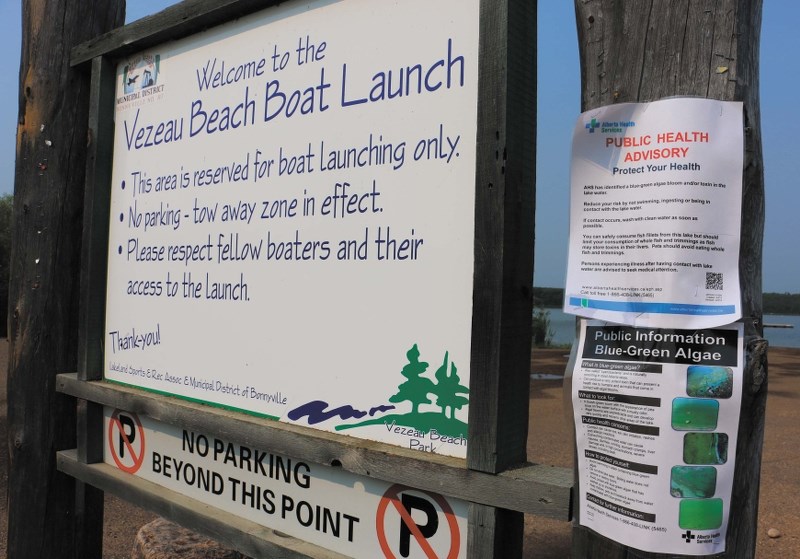Blue-green algae has been blooming in lakes all over the Lakeland over the past number of years with Moose Lake, Muriel Lake, Kehewin Lake and Vincent Lake receiving Alberta Health Services advisories for the toxic cyanobacteria.
“We have had a lot of advisories for blue-green algae in lakes in the region over the past few years. Algae have almost always been present in this area. Its prevalence can be linked to natural and human causes and I think we have a lot of things going on in his area (helping produce) algal blooms,” said Harry Keess, program manager with the Beaver River Watershed Alliance.
However, the problem isn't limited to the Lakeland, as 25 other lakes across Alberta have seen advisories issued for their waters in 2014. Adding to the concern, a 2012 University of Alberta report found blue-green algae present in 246 lakes across the country.
The report, done by U of A researcher Diane Orihel, says that the thick, soupy, blue-green algae is caused by nutrients getting into the water. These nutrients could be from agricultural or industrial run-off.
Keess agrees with Orihel, adding many of the lakes in the Bonnyville region tend to have high nutrient counts and other factors that lead to a good habitat for blue-green algae growth.
“We have fairly sunny summers, fairly low precipitation over the past few decades and a general increase in temperature, which is leading to better conditions for algal blooms to form,” said Keess. “We have very high production in our lakes with a lot of nutrient loading into them resulting in high nutrient content, and with a lot of sunlight that makes for fairly productive lakes which algal blooms thrive in.”
Lakes with blue-green algae blooms will undergo a visible change. The toxin will cause regularly clear, transparent water to become think and soupy in appearance and display a wide variety of colours, most frequently turquoise, bright blue, and green, but also gray, tan and even red.
The algae produces a toxin that can cause a range of health effects in humans and animals that come into contact with it. Alberta Health Services (AHS) advises residents not to drink the water, avoid all contact with the water and limit their consumption of fish from any lake with the algae.
“The health effects can vary depending on how people come into contact with the water,” said Dr. Kathryn Koliaska, Medical Officer for AHS North. “So if it's skin contact from splashing or swimming, it would be more skin irritation. If it was swallowing some water there certainly could be some gastrointestinal kinds of symptoms.”
The algae has a tendency to reoccur in the same lakes and may not be completely absent even though it is not visible to the human eye. Both Moose Lake and Kehewin Lake have had blue-green algae advisories issued on multiple occasions over the past few years, as the algae has reappeared from year to year.
“Even though you might not see the blue-green algae bloom, they do tend to move around and move up and down and the toxin does get everywhere,” said Koliaska, noting that the toxins can stay in the water even after the algae have moved or disappeared.
She added that if you happen to accidentally come in contact with the water you should rinse off the skin with clean water to limit chance of illness.
Possible symptoms of toxins from blue-green algae may include skin irritation, rash, sore throat, sore red eyes, swollen lips, fever, nausea and vomiting.
Keess says that the reoccurring blue-green algae is an overall negative for the entire region's water system as it has wide reaching effects.
“When the blooms get to high levels it has a negative effect on the water quality and health. It is not good for drinking and not good for bathing and it is certainly not healthy for the fish living in the lakes. If the fish aren't doing well it will affect the ecosystems. We are hit pretty hard by it in many different ways.”
Part of the reason why the lakes are so high in nutrients could be contributed to agricultural and industrial run-off going into the lakes, according to Keess.
“Increased development in the area has also increased the nutrients going into lakes and that promotes the growth of blooms,” said Keess. “I think it is a trend that can be partially controlled by reducing human impacts, but climatic sources of algal blooms are something that is not as easy to control. Blue-green algae is something that we need to lookout for, but it is not something that is going to go away easily.”
Anyone who suspects a problem related to blue-green algae can call Health Link Alberta at 1-866-408-4565.
The advisories for Moose Lake, Muriel Lake, Kehewin Lake and Vincent Lake will remain in effect until further notice.



